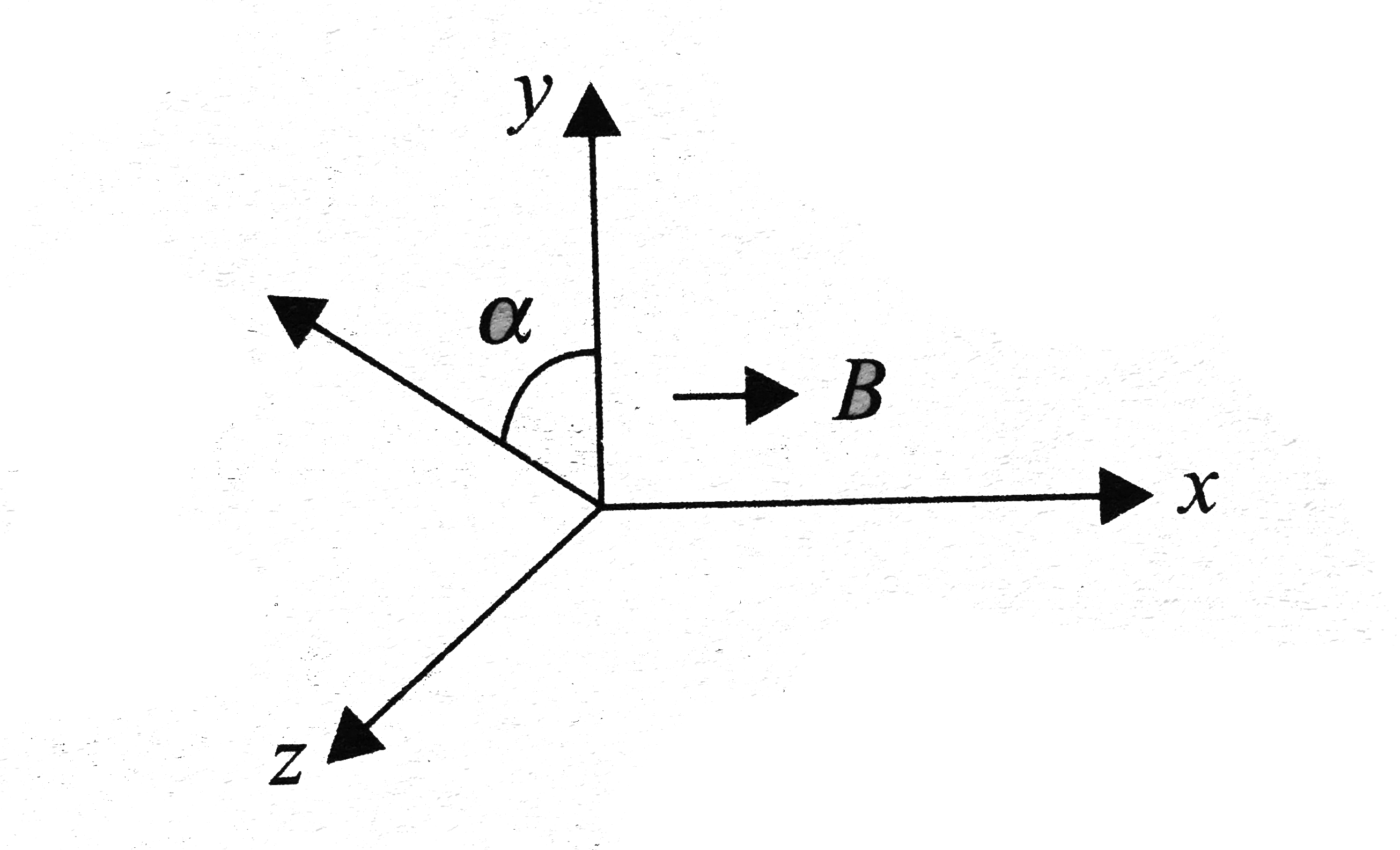In a certain region of space a uniform and constant electric field and a magnetic field parallel to each other are present. A proton is fired from a point A in the field with speed V=4×104m/s at an angle of α with the field direction. The proton reaches a point B in the field where its velocity makes an angle β with the field direction. If sinαsinβ=√3. Find the electric potential difference between the points A and B. Take mp (mass of proton) =1.6×10−27kg and e (magnitude of electronic charge) =1.6×10−19C.
16 V
40 V
90 V
30 V
The correct Answer is:a
To solve the problem, we need to find the electric potential difference between points A and B, given the conditions of the electric and magnetic fields, the velocity of the proton, and the angles involved.
1. Identify Given Values:
- Initial speed of the proton, VA=4×104m/s
- Mass of the proton, mp=1.6×10−27kg
- Charge of the proton, e=1.6×10−19C
- The relationship between angles: sinαsinβ=√3
2. Use the Relationship of Velocities:
- Since the electric and magnetic fields are parallel, the perpendicular components of the velocity remain unchanged. Therefore, we can use the relationship:
VAsinα=VBsinβ
- Rearranging gives:
VAVB=sinβsinα
- Given sinαsinβ=√3, we can write:
VAVB=1√3⟹VB=VA⋅√3
3. Calculate VB:
- Substituting VA:
VB=4×104⋅√3m/s
4. Apply Conservation of Energy:
- The total mechanical energy at points A and B can be expressed as:
12mpV2A+eΔV=12mpV2B
- Rearranging gives:
ΔV=12mpV2B−12mpV2Ae
5. Substitute VB into the Equation:
- Calculate V2B:
V2B=(4×104√3)2=48×108=4.8×109m2/s2
- Calculate V2A:
V2A=(4×104)2=16×108=1.6×109m2/s2
6. Plug Values into the Potential Difference Equation:
- Now substitute into the equation for ΔV:
ΔV=12mp(4.8×109)−12mp(1.6×109)e
- Simplifying gives:
ΔV=12mp(4.8×109−1.6×109)⋅1e
- This simplifies to:
ΔV=12mp(3.2×109)⋅1e
7. Calculate the Final Values:
- Substitute mp and e:
ΔV=12⋅(1.6×10−27)⋅(3.2×109)⋅11.6×10−19
- This results in:
ΔV=(1.6⋅3.2)×10−182⋅1.6×10−19=5.12×10−183.2×10−19=16V
Final Answer:
The electric potential difference between points A and B is ΔV=16V.
- Initial speed of the proton, VA=4×104m/s
- Mass of the proton, mp=1.6×10−27kg
- Charge of the proton, e=1.6×10−19C
- The relationship between angles: sinαsinβ=√3
- Since the electric and magnetic fields are parallel, the perpendicular components of the velocity remain unchanged. Therefore, we can use the relationship:
VAsinα=VBsinβ
- Rearranging gives:
VAVB=sinβsinα
- Given sinαsinβ=√3, we can write:
VAVB=1√3⟹VB=VA⋅√3
- Substituting VA:
VB=4×104⋅√3m/s
- The total mechanical energy at points A and B can be expressed as:
12mpV2A+eΔV=12mpV2B
- Rearranging gives:
ΔV=12mpV2B−12mpV2Ae
- Calculate V2B:
V2B=(4×104√3)2=48×108=4.8×109m2/s2
- Calculate V2A:
V2A=(4×104)2=16×108=1.6×109m2/s2
- Now substitute into the equation for ΔV:
ΔV=12mp(4.8×109)−12mp(1.6×109)e
- Simplifying gives:
ΔV=12mp(4.8×109−1.6×109)⋅1e
- This simplifies to:
ΔV=12mp(3.2×109)⋅1e
- Substitute mp and e:
ΔV=12⋅(1.6×10−27)⋅(3.2×109)⋅11.6×10−19
- This results in:
ΔV=(1.6⋅3.2)×10−182⋅1.6×10−19=5.12×10−183.2×10−19=16V
The electric potential difference between points A and B is ΔV=16V.
Topper's Solved these Questions
- MAGNETIC EFFECT OF CURRENT AND MAGNETISMBOOK - DC PANDEY ENGLISHCHAPTER - MAGNETIC EFFECT OF CURRENT AND MAGNETISMEXERCISE - More than One Option is Correct
25 Videos
- MAGNETIC EFFECT OF CURRENT AND MAGNETISMBOOK - DC PANDEY ENGLISHCHAPTER - MAGNETIC EFFECT OF CURRENT AND MAGNETISMEXERCISE - Comprehension type Questions
16 Videos
- MAGNETIC EFFECT OF CURRENT AND MAGNETISMBOOK - DC PANDEY ENGLISHCHAPTER - MAGNETIC EFFECT OF CURRENT AND MAGNETISMEXERCISE - Integer type Questions
10 Videos
- LAWS OF THERMODYNAMICSBOOK - DC PANDEY ENGLISHCHAPTER - LAWS OF THERMODYNAMICSEXERCISE - Level 2 Subjective
18 Videos
- MEASUREMENT AND ERRORSBOOK - DC PANDEY ENGLISHCHAPTER - MEASUREMENT AND ERRORSEXERCISE - Subjective
19 Videos
Similar Questions
Direction of magnetic field at equatorial point
View SolutionIn a region of space, a uniform magnetic field B exists in the y direction. A proton is fired from the origin, with its initial velocity v making a small angle α with the y direction in the yz plane. In the subsequent motion of the proton,

View SolutionA uniform electric field and a uniform magnetic field are acting along the same direction in a certain region. If an electron is projected along the direction of the fields with a certain velocity then
View SolutionA uniform electric field and a uniform magnetic field are acting along the same direction in a certain region. If an electron is projected along the direction of the fields with a certain velocity then
View SolutionA uniform electric field and a uniform magnetic field are acting along the same direction in a certain region. If an electron is projected along the direction of the fields with a certain velocity then
View SolutionIn a region, steady and uniform electric and magnetic fields are present . These two fields are parallel to each other. A charged particle is released from rest in this region . The path of the particle will be a
View SolutionA proton of mass m and charge q enters a magnetic field B with a velocity v at an angle θ with the direction of B.The radius of curvature of the resulting path is
View SolutionAn electric field (vec E) and a magnetic field (vec B)exist in a region . The fields are not perpendicular to each other.
View SolutionIn a region of space, a uniform magnetic field B exists in the x-direction. An electron is fired from the origin with its initial velocity u making an angle α with the y direction in the y-z plane. In the subsequent motion of the electron,

View SolutionA uniform electric field and a uniform magneitc field exist in a region in the same direction An electron is projected with velocity pointed in the same direction the electron will
View Solution
